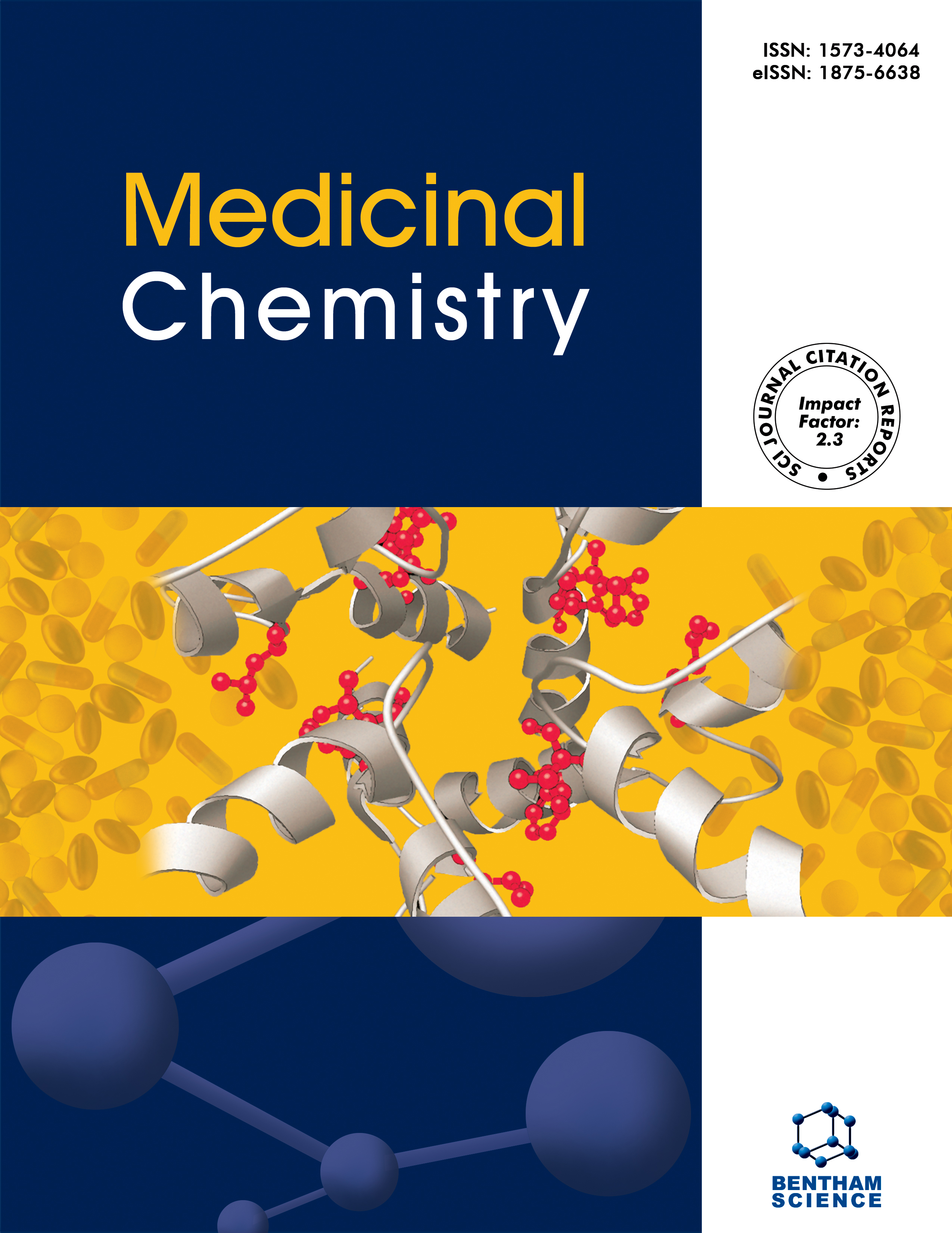- Home
- A-Z Publications
- Medicinal Chemistry
- Previous Issues
- Volume 19, Issue 5, 2023
Medicinal Chemistry - Volume 19, Issue 5, 2023
Volume 19, Issue 5, 2023
-
-
Would the Development of a Multitarget Inhibitor of 3CLpro and TMPRSS2 be Promising in the Fight Against SARS-CoV-2?
More LessAuthors: Igor Josos Santos Nascimento and Ricardo Olimpio de MouraSevere Acute Respiratory Syndrome Coronavirus 2 (SARS-CoV2), responsible for generating COVID-19, has spread worldwide and was declared a pandemic by the World Health Organization (WHO) on 11 March 2020, being responsible for various damages to public health, social life, and the economy of countries. Its high infectivity and mutation rates have stimulated researchers and pharmaceutical companies to search for Read More
-
-
-
Isatin Conjugates as Antibacterial Agents: A Brief Review
More LessAuthors: Firoj Hassan, Iqbal Azad, Mohd Asif, Deepanjali Shukla, Atif Husain, Abdul R. Khan, Mohammad Saquib and Malik NasibullahPathogenic bacteria, with their innate resistance to drugs, pose a constant threat to human health and well-being and put a persistent strain on the health care system. Development of more effective and safer novel antibacterial drugs is warranted to counter the menace unleashed by pathogenic bacteria. Integration of privileged pharmacophores from various bioactive molecules into a single template is a promising st Read More
-
-
-
In-Silico Prediction of Novel Fused Quinazoline Based Topoisomerase Inhibitors as Anticancer Agents
More LessAuthors: Mukesh K. Kumawat, Ramandeep Kaur and Kapil KumarBackground: The prospective uses of tryptanthrin and its analogues in cancer chemotherapy are well known, and they are also predicated on their capacity to reverse drug resistance in cancer therapy. Objective: The current project entails developing a novel hybrid analogue that includes modifying the tryptanthrin molecule at the C-6 carbonyl position and is expected to exhibit substantial anticancer action. Methods: In the Read More
-
-
-
New Niflumic Acid Derivatives as EGFR Inhibitors: Design, Synthesis, In-Silico Studies, and Anti-proliferative Assessment
More LessAuthors: Yahya S. Yaseen, Ammar A.R. Mahmood, Ali H. Abbas, Wurood A. Shihab and Lubna H. TahtamouniBackground: 1,3,4-oxadizole and pyrazole derivatives are very important scaffolds for medicinal chemistry. A literature survey revealed that they possess a wide spectrum of biological activities including anti-inflammatory and antitumor effects. Objectives: To describe the synthesis and evaluation of two classes of new niflumic acid (NF) derivatives, the 1,3,4-oxadizole derivatives (compounds 3 and (4A-E) and pyrazole de Read More
-
-
-
Anticancer Activity of 3,5-Bis(dodecyloxy)Benzoate-PAMAM Conjugates with Indomethacin or Mefenamic Acid
More LessBackground: The synthesis of conjugates with nonsteroidal anti-inflammatory drugs could improve their activity with less toxicity and these compounds could be used for the treatment of cancer. Objective: The aim of the present investigation was the synthesis of 3,5-bis(dodecyloxy)benzoate - PAMAM conjugates with indomethacin and mefenamic acid to examine their anticancer activity. Methods: The Read More
-
-
-
Synthesis, Cytotoxicity and Antiviral Activity Against Vaccinia Virus of 2-(3-Coumarinyl)-1-Hydroxyimidazoles
More LessBackground: In 1980, smallpox became the first viral disease eradicated through vaccination. After the termination of the Smallpox Eradication Program, the global immunization of the population also ceased. Now, most people do not have any immunity against infections caused by orthopoxviruses. Emerging cases of zoonotic orthopox infections transferring to humans inspire the search for new small organic molec Read More
-
-
-
Synthesis and In vitro Efficacy of Tetracyclic Benzothiazepines Against Blood-Stage Plasmodium falciparum and Liver-Stage P. berghei
More LessObjective: A series of novel, substituted tetracyclic benzothiazepines were designed and prepared in an effort to optimize the potency of this chemical class against drug-resistant strains of the malaria parasite. Methods: Tetracyclic benzothiazepines bearing structural modification at seven distinct positions within the structure were synthesized in Knoevenagel condensation reactions followed by sequential intermolecular thi Read More
-
-
-
Synthesis and Molecular Docking of New N-Acyl Hydrazones- Benzimidazole as hCA I and II Inhibitors
More LessBackground: The carbonic anhydrases (CAs) which are found in most living organisms is a member of the zinc-containing metalloenzyme family. The abnormal levels and activities are frequently associated with various diseases therefore CAs have become an attractive target for the design of inhibitors or activators that can be used in the treatment of those diseases. Methods: Herein, we have designed and synthesized new be Read More
-
-
-
A Complex Methodological Approach for the Screening of Efficient and Safe Cobalt Chelators
More LessBackground: Cobalt is an essential trace element, but it can also rarely cause cobalt toxicity due to its release from cobalt-containing medical devices. Currently, there are no approved selective cobalt chelators, which would represent an optimal treatment modality. Objective: This study aimed to develop a simple and complex methodological approach for screening potential cobalt chelators and evaluating their potential Read More
-
Volumes & issues
-
Volume 21 (2025)
-
Volume 20 (2024)
-
Volume 19 (2023)
-
Volume 18 (2022)
-
Volume 17 (2021)
-
Volume 16 (2020)
-
Volume 15 (2019)
-
Volume 14 (2018)
-
Volume 13 (2017)
-
Volume 12 (2016)
-
Volume 11 (2015)
-
Volume 10 (2014)
-
Volume 9 (2013)
-
Volume 8 (2012)
-
Volume 7 (2011)
-
Volume 6 (2010)
-
Volume 5 (2009)
-
Volume 4 (2008)
-
Volume 3 (2007)
-
Volume 2 (2006)
-
Volume 1 (2005)
Most Read This Month
Article
content/journals/mc
Journal
10
5
false
en


